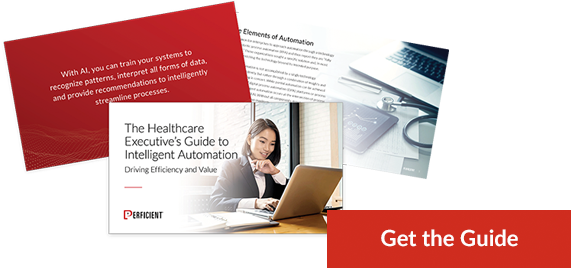Despite the billions spent each year to digitize processes, companies are not operating at their maximum potential. This is due in part to the fact that processes are forced to run across a rigid and fragmented technology landscape. Instead of creating value, digitization is creating execution gaps.
Common signs that your organization is suffering from execution gaps:
- Inability to measure how your processes really run
- You do not know which gaps and root causes have the biggest impact on your KPIs
- You cannot act quickly enough (or do not have the means to remove) the gaps in the underlying transactional systems, forcing costly action workarounds
The flexible, personalized, and highly complex nature of “careflows” offers a high-impact opportunity to optimize processes and, ultimately, deliver greater value to healthcare consumers.
Ideally, process mining combines the use of sophisticated mathematical models and algorithms with human expertise to discover patterns, analyze, and quantify improvement areas across all systems involved in a process. After discovering and analyzing these complete business processes, they can be optimized and automated for real, tangible, impactful results.
3 Stages of Process Mining
- Measure: Measure capacity and see how processes really run. An ideal solution combines top-performing analysts with cutting-edge AI.
- Know: Know which gaps have the greatest impact, and the right course of action to close them. View custom-tailored results to make data-driven decisions that clearly outline opportunities and plans.
- Act: Act to remove gaps in real time and unlock your capacity. Accelerate implementation with proven delivery methodologies that power seamless execution on the plan.
Our new guide The Healthcare Executive’s Guide to Intelligent Automation explores how process mining, digital process automation (DPA), robotic process automation (RPA), and artificial intelligence (AI) – working in concert – can heighten efficiencies and increase value within healthcare organizations. The following topics are examined:
- How automation drives efficiency and value in healthcare
- Key automation trends and drivers of adoption
- Core elements of a successful automation strategy
- Best practices and steps to get started
Why Perficient
We blend healthcare and automation expertise to help you build stronger teams and establish optimal processes. Our experts will help you identify how work is performed today and how you can optimize for tomorrow.
We work with partners that address the key elements of intelligent automation with their best-in-class product offerings. Your needs are unique, and we can help you determine the product or system for your particular use case. We also provide readiness evaluations, business case development, implementation and migration services, and rapid development and pilots.
We are recognized by Modern Healthcare as a key healthcare consulting leader. Additionally, Perficient was cited as a “Contender” in The Forrester Wave™: Digital Process Automation Service Providers, Q3 2020 report.


